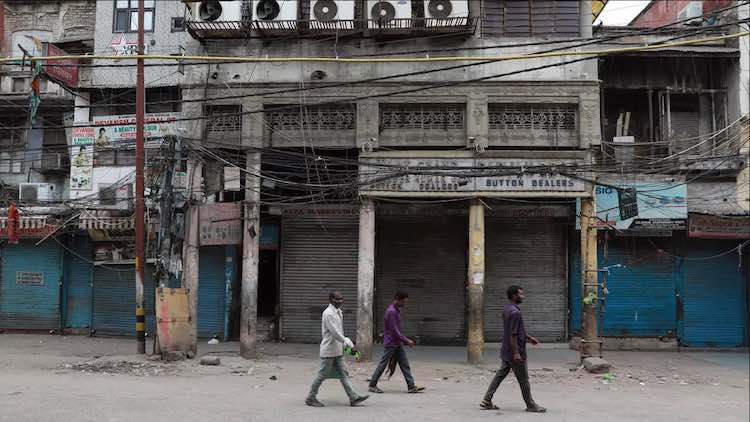How India's Lockdown Has Failed To Curb COVID-19

Contrary to the Centre's claim, lockdown 3.0 falls flat as COVID-19 cases saw an exponential rise in the country. India, where social distancing norms can't be followed by all due to various circumstances, has suffered huge economic repercussions due to the prolonged lockdown.
Due to the 50-day nationwide lockdown, businesses, traders and labourers are on the brink of decimation and the purview of the coronavirus contagion is increasing.
Lockdown 3.0 is about to end and over 70,000 people have been infected with the coronavirus so far. While the Central government says that the coronavirus crisis has been abated to a large extent due to its decisions, statistics are narrating another story altogether. If figures are anything to go by, then the lockdown has failed badly in the country and there has been the biggest spike in the number of patients during Lockdown 3.0. In India, a country with a high population density, rules such as social distancing and self-isolation are not practical. The highest number of coronavirus cases in the country (23,401) has been reported in Maharashtra, where a large population lives in one-room dwellings. According to a 2014 Census Report, in Maharashtra, 49.6% homes in cities and 29.4% houses in villages are one-room dwellings, where an entire family resides. For these families, words like social distancing and self-isolation are meaningless. With 8,541 cases, Gujarat is on the second spot, where 39.9% homes in villages and 34.6% houses in cities are one-room dwellings. In Tamil Nadu, 8,002 cases have come to light. Over here, 48.4% homes in villages and 43.2% houses in cities are one-room dwellings, where the entire family lives. In Delhi, 7,233 cases have been reported so far. Over here, 31.4% homes in villages and 39.7% houses in cities are one-room dwellings, where a whole family resides. For the moment, the cases of infection in these three states and one Union Territory are the highest and over here, a large proportion of the population lives in one-room houses. Meanwhile, the spread of the contagion has been limited in states where a large number of people live in two or three-room houses. In Kerala, only 519 cases have come to light. Over here, only 2.5% families in cities and 3.5% families in villages live in a one-room dwelling and there are no homeless families in this state. Similarly, in Assam, which has 65 coronavirus cases, 22.8% homes in cities and 24.6% houses in villages are one-room dwellings. In Chhattisgarh, only 59 cases have come to light so far. In this state, 22.6% families in cities and 26.2% families in villages live in a one-room house. In Jharkhand, 160 cases have been reported so far. Over here, 26% families in villages and only 18% families in cities live in a one-room dwelling. These figures reveal that measures taken to combat the coronavirus have proven effective in states with lesser population density and larger houses. Just before the Janta Curfew was imposed, GoNews had questioned how social isolation will be possible in a country where around 40 crore people live in one-room dwellings. Watch the video story here:
Lockdown 3.0 is about to end and over 70,000 people have been infected with the coronavirus so far. While the Central government says that the coronavirus crisis has been abated to a large extent due to its decisions, statistics are narrating another story altogether. If figures are anything to go by, then the lockdown has failed badly in the country and there has been the biggest spike in the number of patients during Lockdown 3.0. In India, a country with a high population density, rules such as social distancing and self-isolation are not practical. The highest number of coronavirus cases in the country (23,401) has been reported in Maharashtra, where a large population lives in one-room dwellings. According to a 2014 Census Report, in Maharashtra, 49.6% homes in cities and 29.4% houses in villages are one-room dwellings, where an entire family resides. For these families, words like social distancing and self-isolation are meaningless. With 8,541 cases, Gujarat is on the second spot, where 39.9% homes in villages and 34.6% houses in cities are one-room dwellings. In Tamil Nadu, 8,002 cases have come to light. Over here, 48.4% homes in villages and 43.2% houses in cities are one-room dwellings, where the entire family lives. In Delhi, 7,233 cases have been reported so far. Over here, 31.4% homes in villages and 39.7% houses in cities are one-room dwellings, where a whole family resides. For the moment, the cases of infection in these three states and one Union Territory are the highest and over here, a large proportion of the population lives in one-room houses. Meanwhile, the spread of the contagion has been limited in states where a large number of people live in two or three-room houses. In Kerala, only 519 cases have come to light. Over here, only 2.5% families in cities and 3.5% families in villages live in a one-room dwelling and there are no homeless families in this state. Similarly, in Assam, which has 65 coronavirus cases, 22.8% homes in cities and 24.6% houses in villages are one-room dwellings. In Chhattisgarh, only 59 cases have come to light so far. In this state, 22.6% families in cities and 26.2% families in villages live in a one-room house. In Jharkhand, 160 cases have been reported so far. Over here, 26% families in villages and only 18% families in cities live in a one-room dwelling. These figures reveal that measures taken to combat the coronavirus have proven effective in states with lesser population density and larger houses. Just before the Janta Curfew was imposed, GoNews had questioned how social isolation will be possible in a country where around 40 crore people live in one-room dwellings. Watch the video story here:
Latest Videos
















